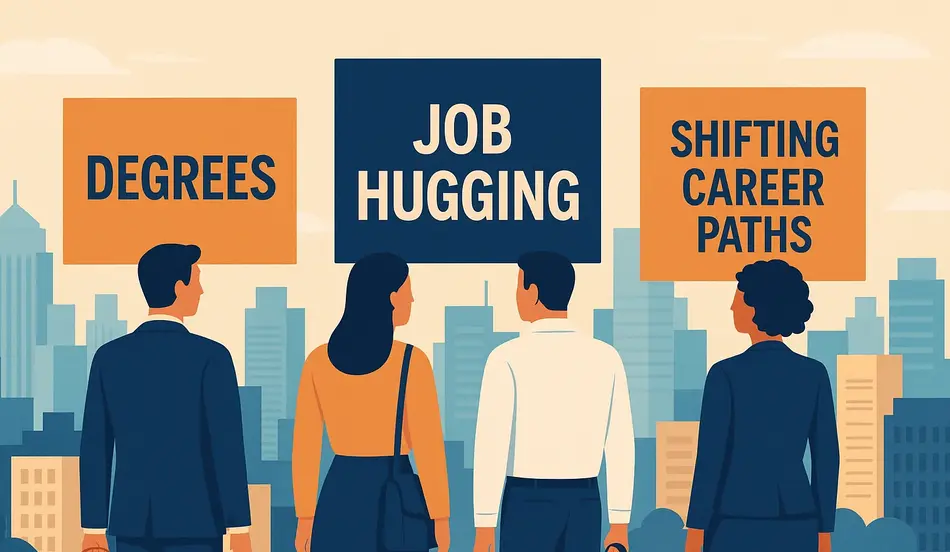The job market has undergone dramatic changes in just the last six months. Trends that dominated headlines in 2025—like quiet firing, digital downsizing, ghost jobs, and rolling layoffs—have been replaced by new challenges and equally confusing buzzwords. For young professionals, and particularly young men, these changes are reshaping what it means to find, keep, and grow in a career.
Beneath the noise of corporate jargon, the data tells a more serious story: unemployment among young male college graduates has now reached the same level as their non-graduate peers. Job mobility has slowed to a crawl. And in many cases, entry-level jobs are harder to secure today than at any point in the last decade.
The Degree Advantage Is Weakening—but Not Gone
A striking data point has emerged: unemployment rates for male college graduates and non-graduates are now equal for the first time. On the surface, this could suggest that the financial payoff of a degree has vanished. But the picture is more nuanced.
While the unemployment rate is the same, college graduates generally still secure higher-paying roles once employed. Engineers, analysts, and professionals in specialized fields are better positioned than workers seeking unskilled jobs. Degrees also increase long-term labor participation: about 72% of those with a bachelor’s or higher are engaged in the labor force compared to just 56% of high school graduates.
The challenge lies in timing and cost. The traditional payoff of higher lifetime earnings is becoming harder to justify for young people saddled with debt. Many are beginning to question whether steady income without tuition loans is more valuable than chasing delayed earnings that may never fully materialize.
Why Gender Gaps Are Telling a Different Story
The recent graduate employment problem primarily affects men. Women with degrees still enjoy a measurable employment advantage compared to women without degrees. In fact, their unemployment gap remains wide and has even grown, while men’s advantage has disappeared.
Several forces explain this:
- Push for women in STEM and management: Decades of government programs and corporate initiatives have expanded opportunities for women in traditionally male-dominated fields requiring degrees. This widens competition and reduces the advantage for men.
- Stable demand in traditionally female fields: Roles in healthcare, teaching, and social services remain resilient in downturns. These fields are often less cyclical than business, tech, or finance, which male graduates have historically favored.
- Cultural stigmas: Despite progress, men entering nursing, teaching, or caregiving roles still face outdated stereotypes. This limits participation in the very fields proving most secure today.
The result is a bifurcated market: women in degree-dependent careers are seeing more stability, while men in “prestigious” fields are experiencing more volatility.
The Rise of “Job Hugging”
One of the most important shifts in 2025 is the collapse of the job-hopping premium. For years, analysts warned that staying too long with one employer limited earning potential. Switching jobs every few years was statistically the fastest way to boost income.
But in today’s climate, job mobility has effectively frozen. Wage growth has slowed, companies are cautious about hiring, and employees fear layoffs. As a result, many workers are embracing a new strategy—dubbed “job hugging.”
Job hugging means holding on to one’s current role, even if better opportunities exist elsewhere. Workers prioritize stability over advancement, reasoning that staying beyond probation in a familiar company feels safer than risking a new role during turbulent times.
This trend benefits employees in fields less prone to boom-and-bust cycles. Arts graduates, for instance, often enter careers out of passion rather than financial incentives. Their lower-risk approach—staying in one role and building deep expertise—has made them more resilient than graduates chasing high-paying but unstable roles in tech or finance.
Need Stable, Long-Term Talent?
As more workers embrace “job hugging,” now is the time to post your jobs on WhatJobs and attract candidates who value security and loyalty.
👉 Post a Job Now →Why Men and Women Are Experiencing Different Outcomes
The divergence between male and female employment trends reflects deeper structural and cultural factors:
- Field of study: Men continue to concentrate in business, finance, and tech—industries experiencing volatility. Women are overrepresented in education and healthcare, which remain more stable.
- Layoff patterns: Research shows that women have been disproportionately affected in recent tech layoffs, partly because they were concentrated in HR, marketing, and culture teams—the first departments cut during downsizing.
- Cultural perceptions: Men in caregiving or teaching roles may find advancement easier due to the “glass elevator effect,” where men in female-dominated industries rise faster. Conversely, women in high-paying fields are often judged more harshly and face greater layoff risks.
Taken together, these trends suggest that traditional career strategies may no longer guarantee security or advancement. Instead, adaptability, diversification of skills, and openness to non-traditional fields are becoming critical.
What This Means for Graduates
For new graduates, especially men, the message is clear: the old formula of “get a degree, land a high-paying job, and climb the ladder” no longer guarantees success. Instead:
- Expect volatility in trendy industries: Tech and finance may not provide the stability they once did.
- Consider stable growth sectors: Healthcare, education, infrastructure, and renewable energy continue to show consistent demand.
- Balance early income vs. long-term payoff: Graduates must weigh the burden of debt against delayed earnings, especially if industries shift before returns materialize.
- Invest in transferable skills: Communication, management, and problem-solving remain valuable across all fields.
Conclusion
The labor market in 2025 is forcing young workers to rethink career strategies. Degrees still provide advantages, but the payoff is shrinking, particularly for men. Job mobility is stalling, and “job hugging” has become the rational response in uncertain times. Meanwhile, gender-based differences highlight the importance of field selection and cultural perceptions in shaping outcomes.
As industries evolve and economic cycles continue, the safest path for graduates may be to focus less on prestige and more on resilience, adaptability, and long-term sustainability.
FAQs
Is a college degree still worth it in 2025?
Yes, but the advantage has weakened. Degrees still lead to higher-paying jobs on average, but debt and delayed earnings reduce the payoff, especially for men in volatile industries.
What is “job hugging”?
Job hugging is the trend of holding on tightly to a current role rather than seeking promotions or new jobs, prioritizing stability in uncertain economic times.
Why are male graduates struggling more than female graduates?
Male graduates are concentrated in fields like business and tech, which face higher volatility. Women, overrepresented in healthcare and education, are faring better in today’s market.
Which industries are safest for graduates today?
Healthcare, teaching, infrastructure, and sustainability-related fields are proving resilient compared to cyclical industries like tech and finance.
Should young professionals still switch jobs to increase pay?
Historically yes, but the current slowdown has erased much of the job-hopping premium. In 2025, stability may outweigh the benefits of frequent moves.






